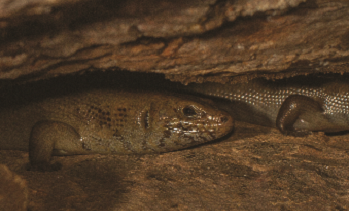Conserving the Arnhem Land Gorges Skink in Kakadu National Park
The Arnhem Land Gorges Skink (Bellatorias obiri) is one of Australia’s most threatened species, and at high risk of becoming extinct by 2040. With very few known records from the past 20 years, and the species only being known to persist at a single location, it is in dire need of surveys and protection.
Led by Dr Emily Hoffmann, from Territory Natural Resource Management, this project is working closely with Traditional Owners to survey areas of Kakadu National Park from which the species was formerly known to occur. These surveys were conducted over the 2022-2023 wet season using camera traps and eDNA analysis. These methods were chosen because active searching produces poor results when the skinks spend so much of their time deep in rock crevices.
Check out the Territory NRM website for more information about the project.
Progress
This project has produced some fantastic results, with camera traps detecting Arnhem Land Gorges Skinks at five of the seven historical locations surveyed, with the skinks appearing to persist in small numbers at each site. This will allow Kakadu National Park to better protect and manage the species, as well as provide baseline data for future monitoring. Interestingly, eDNA analysis was able to confirm that one collected scat belonged to an Arnhem Land Gorges Skink, but did not detect the species in samples of water and soil collected from in or near crevices that were being actively used. This suggests that eDNA methods may not be effective for targeted or community-level surveys for reptiles in these types of environments. Manuscripts are currently being written up for publication.
Further research and monitoring at sites where populations of Arnhem Land Gorges Skinks are known to persist will help to identify whether the species is continuing to decline, as well as tell us whether factors such as feral cats (Felis catus) or inappropriate fire regimes are increasing mortality rates and reducing population growth rates.
While Emily is moving on to new and interesting projects, the project team will try to ensure that this species is prioritised for conservation management and research.
